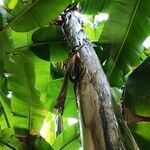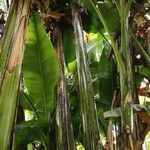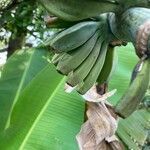The false stems are 2.5-4 m long. The leaf stalk is 30 cm long. The leaf blade is bright green and oblong. It is 2-3 m long by 30 cm wide. The base is rounded and unequal. The flowering stalk hangs down. The bracts are red-brown to purple. There are 10-16 male flowers per bract in 2 rows. The fruit are berries with are oblong and 3-5 sided. There are many seeds. These are black and irregular angled. They are 6-8 mm wide.



